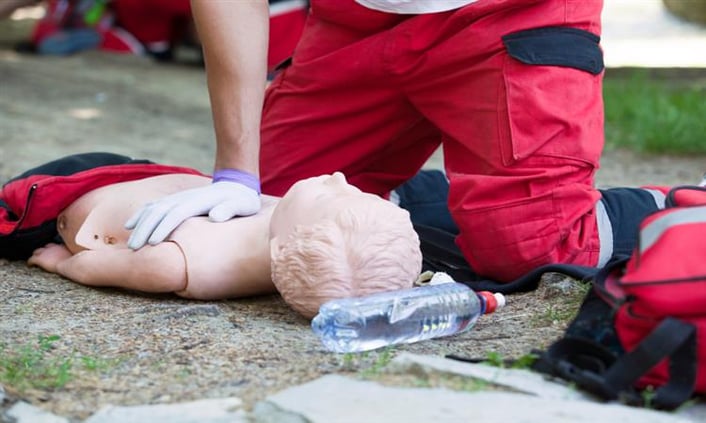 Whoever said “children are just small adults” never had to work on one in an emergency setting. Calls involving pediatric patients can be some of the most challenging you as a paramedic may encounter. Pediatric calls occur with less frequency than those involving adults, resulting in rusty skills and lack of confidence when treating juvenile patients.
Whoever said “children are just small adults” never had to work on one in an emergency setting. Calls involving pediatric patients can be some of the most challenging you as a paramedic may encounter. Pediatric calls occur with less frequency than those involving adults, resulting in rusty skills and lack of confidence when treating juvenile patients.
So let’s go over some of the distinguishing factors to consider when treating pediatric patients. It all begins with the assessment.
Assessing the pediatric patient
Dealing with children requires a different set of skills than dealing with adults. And dealing with sick children compounds those differences. A child leery of strangers will be doubly so if that child is sick or in pain, making your job that much harder. So here are a few tips when assessing the pediatric patient:
- Scene Size-Up – As you approach the scene/patient, look for possible safety threats that would endanger the child. The condition of the house, the interaction of parents/caregivers with the patient, and your overall impression of the scene can say a lot about the child’s day-to-day wellbeing, so be alert and document what you see.
- General Appearance – Sick kids are easy to distinguish from well kids. Here are a few quick hints:
- Is the child exhibiting good muscle tone or are they limp and lifeless during assessment?
- Is the child interacting with you or their caregiver, or are the disinterested?
- Can the child be consoled or are they agitated and crying?
- Does the child make eye contact or is their gaze glazed over?
- If they are crying, is it a strong cry or are they merely whimpering?
- The general appearance of the child is the first indication of their condition and it can be assessed in mere seconds.
- Breathing – A great way to assess the airway is to gauge the work of breathing. These signs indicate your patient is having to exhibit extra effort to breath. For example:
- Are they in the sniffing or tripod position?
- Are they exhibiting retractions of the rib cage?
- What about nasal flaring?
- Circulation – Assess heart rate, capillary refill, and blood pressure, keeping in mind age-appropriate rates/ranges.
- Temperature – Assess the temperature, keeping in mind children may have cool hands and feet.
Anatomic changes in children
The rapid growth in children means their bodies are constantly changing. Familiarizing yourself with the anatomical changes that take place during growth will aid in your assessment and ultimate treatment of pediatric patients, especially when it comes to airway management. Here are a few things to keep in mind:
- Neck and Airway
- The neck elongates as the vertebrae grow.
- Landmarks will change in shape, size, and location.
- The larynx will widen and elongate at around 3 years of age, with another growth spurt to follow at puberty.
- The trachea will increase in circumference by 300% by the time the child reaches puberty.
- Chest and Lungs
- As infants grow, their chest walls flatten out.
- Thin chest walls mean heart and lung sounds are transmitted throughout.
- Breath sounds may be audible on inspiration and expiration.
- Infants are notorious belly-breathers, but this will shift once the child reaches six years of age.
- The number of alveoli increase until eight years of age, after which they will grow larger.
- Heart
- A right axis deviation on the ECG is normal for infants, due to similarity in size of the ventricles at birth.1
- The left ventricle will reach normal proportions by the age of one.
- Abdomen
- Newborns have big bellies due to the size and arrangement of their internal organs at birth.
- Toddlers also exhibit bigger bellies due to normal curvature of the spine that diminishes as they grow.
- Musculoskeletal System
- The growth plates in children’s bones are subject to fracture due to their inherent weakness.
- Growth is more rapid in the lower extremities before puberty, while the trunk grows more during puberty.
- Two year olds experience a growth spurt in muscle mass, as do children at puberty.
- Nervous System
- Infants experience rapid growth of their nervous systems.
- By seven years of age, brain size is 90% that of an adult.
- The rapid growth of the brain is typically accompanied by dramatic increases in fine and gross motor skills, as well as language skills.
Children are not simply smaller adults, and they require a unique approach to assessment and treatment. Familiarizing yourself with the anatomic and physiologic variances of pediatric patients will aid in your approach to treating a broad range of medical emergencies, but especially those involving the airway.
12014 Pediatric Education for Prehospital Professionals, American Academy of Pediatrics, Jones & Bartlett.














